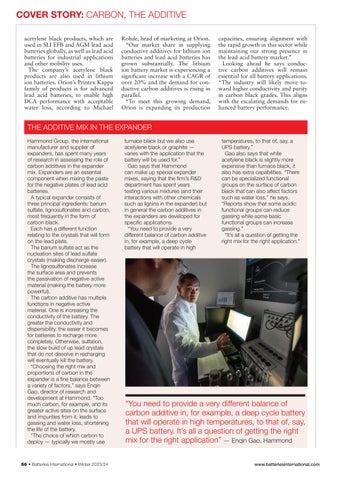COVER STORY: CARBON, THE ADDITIVE acetylene black products, which are used in SLI EFB and AGM lead acid batteries globally, as well as lead acid batteries for industrial applications and other mobility uses. The company’s acetylene black products are also used in lithium ion batteries. Orion’s Printex Kappa family of products is for advanced lead acid batteries, to enable high DCA performance with acceptable water loss, according to Michael
Rohde, head of marketing at Orion. “Our market share in supplying conductive additives for lithium ion batteries and lead acid batteries has grown substantially. The lithium ion battery market is experiencing a significant increase with a CAGR of over 20% and the demand for conductive carbon additives is rising in parallel. “To meet this growing demand, Orion is expanding its production
capacities, ensuring alignment with the rapid growth in this sector while maintaining our strong presence in the lead acid battery market.” Looking ahead he says conductive carbon additives will remain essential for all battery applications. “The industry will likely move toward higher conductivity and purity in carbon black grades. This aligns with the escalating demands for enhanced battery performance.
THE ADDITIVE MIX IN THE EXPANDER Hammond Group, the international manufacturer and supplier of expanders, has spent many years of research in assessing the role of carbon additives in the expander mix. Expanders are an essential component when mixing the paste for the negative plates of lead acid batteries. A typical expander consists of three principal ingredients: barium sulfate, lignosulfonates and carbon, most frequently in the form of carbon black. Each has a different function relating to the crystals that will form on the lead plate. The barium sulfate act as the nucleation sites of lead sulfate crystals (making discharge easier). The lignosulfonates increase the surface area and prevents the passivation of negative active material (making the battery more powerful). The carbon additive has multiple functions in negative active material. One is increasing the conductivity of the battery. The greater the conductivity and dispersibility, the easier it becomes for batteries to recharge more completely. Otherwise, sulfation, the slow build of up lead crystals that do not dissolve in recharging will eventually kill the battery. “Choosing the right mix and proportions of carbon in the expander is a fine balance between a variety of factors,” says Enqin Gao, director of research and development at Hammond. “Too much carbon, for example, and its greater active sites on the surface and impurities from it, leads to gassing and water loss, shortening the life of the battery. “The choice of which carbon to deploy — typically we mostly use
56 • Batteries International • Winter 2023/24
furnace black but we also use acetylene black or graphite — varies with the application that the battery will be used for.” Gao says that Hammond can make up special expander mixes, saying that the firm’s R&D department has spent years testing various mixtures (and their interactions with other chemicals such as lignins in the expander) but in general the carbon additives in the expanders are developed for specific applications. “You need to provide a very different balance of carbon additive in, for example, a deep cycle battery that will operate in high
temperatures, to that of, say, a UPS battery.” Gao also says that while acetylene black is slightly more expensive than furnace black, it also has extra capabilities. “There can be specialized functional groups on the surface of carbon black that can also affect factors such as water loss,” he says. “Reports show that some acidic functional groups can reduce gassing while some basic functional groups can increase gassing.” “It’s all a question of getting the right mix for the right application.”
“You need to provide a very different balance of carbon additive in, for example, a deep cycle battery that will operate in high temperatures, to that of, say, a UPS battery. It’s all a question of getting the right mix for the right application” — Enqin Gao, Hammond www.batteriesinternational.com
